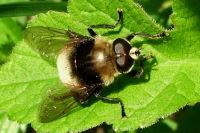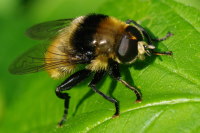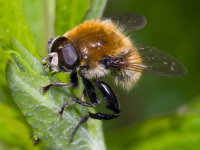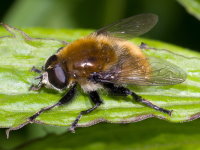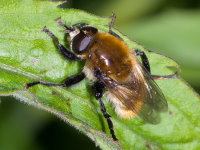Phylum Arthropoda (Arthropods) ➔ Subphylum Hexapoda (Hexapods) ➔ Class Insecta (Insects) ➔ Order Diptera (True flies) ➔ Family Syrphidae (Hoverflies)
Merodon equestris (Fabricius, 1794)
Gemeine Narzissenschwebfliege Large Narcissus Fly
Synonyms and other combinations:
Eristalis ferrugineus Fabricius, 1805 | Eristalis narcissi Fabricius, 1805 | Merodon bulborum Rondani, 1845 | Merodon constans Wiedemann, 1822 | Merodon nigrithorax Bezzi, 1900 | Merodon nobilis Meigen, 1822 | Merodon transversalis Wiedemann, 1822 | Merodon tuberculatus Rondani, 1845 | Merodon validus Wiedemann, 1822 | Musca bombyliformis Geoffroy, 1785 | Syrphus flavicans Fabricius, 1794 |
Further vernacular names:
Narcissus Bulb FlyClassification:
Merodon equestris belongs to the subfamily Eristalinae, tribe Merodontini (=Eumerini).Distribution:
Fennoscandia south to Iberia and the Mediterranean, including North Africa; from Ireland eastwards through much of Europe into European parts of Russia; also in Japan; in North America from British Colombia south to California.As a result of the international trade in flower bulbs, the species has spread across much of the world, including New Zealand.
Habitat:
Deciduous forest/open ground; open areas in moist deciduous forests, also in gardens and horticultural land, at higher altitudes up to the subalpine zone.Description:
Body length 12 - 15 mm; appearance bumblebee-like; body strong, stocky, dense and long-haired; legs completely black, hind tibia of the males with 2 humps and 1 spur.The coloration of the hair of Merodon equestris is extremely variable. There are various genetically determined color forms. The forms bulborum, equestris, flavicans and transversalis occur in both sexes, nobilis and validus only in the females.
Biology:
The Large Narcissus Fly Merodon equestris flies in one generation from May to July (in southern Europe already in April and at higher altitudes in August). The adults fly low and fast zigzagging. They visit various flowers from different plant families, such as umbellifers, Ajuga, Cirsium, Crepis, Hieracium, Knautia arvensis, Papaver, Ranunculus, Rubus idaeus and Senecio. Males exhibit territorial behaviour. They routinely patrol and defend their territories by repelling other insects away. The females start on average from the fourth day of life with the oviposition. The eggs, usually one egg per plant, are placed at the base of the leaves of a suited host plant or in the adjacent soil. Known hostplants of the larvae are daffodil, hyacinth, amaryllis, ismene and snowdrop. After about 10 to 12 days, the larvae hatch. The larvae feed and develop for about 4 months in the bulbs. The adult 3rd instar larvae overwinter in the bulbs. At the end of winter, the larvae leave the bulbs to pupate in the soil litter. The pupal stage lasts about 3 - 4 weeks. The adults hatch in May or June.Merodon equestris can cause considerable damage in commercial flower bulb cultivation and is therefore controlled.
Predators:
Rhembobius abdominalis (Provancher, 1874) from the parasitic wasp family (Ichneumonidae).References, further reading, links:
- Pape T. & Thompson F.C. (eds) (2017). Systema Dipterorum (version 2.0, Jan 2011). In: Species 2000 & ITIS Catalogue of Life, 2017 Annual Checklist (Roskov Y., Abucay L., Orrell T., Nicolson D., Bailly N., Kirk P.M., Bourgoin T., DeWalt R.E., Decock W., De Wever A., Nieukerken E. van, Zarucchi J., Penev L., eds.). Digital resource at www.catalogueoflife.org/annual-checklist/2017. Species 2000: Naturalis, Leiden, the Netherlands. ISSN 2405-884X.
- Gerald Bothe: Bestimmungsschlüssel für die Schwebfliegen (Diptera, Syrphidae) Deutschlands und der Niederlande, DJN, 1984, ISBN 3-923376-07-3
- M.C.D.Speight: Species Accounts of European Syrphidae (Diptera), Glasgow 2011, Syrph the Net, the database of European Syrphidae, vol. 65, 285 pp., Syrph the Net publications, Dublin.
- Menno Reemer, Willem Renema, Wouter van Steenis, Theo Zeegers, Aat Barendregt, John T. Smit, Mark P. van Veen, Jeroen van Steenis, Laurens van der Leij: De Nederlandse Zweefvliegen (Diptera: Syrphidae), Nederlandse Fauna 8, 2009.
- Anasimyia interpuncta
- Anasimyia transfuga
- Baccha elongata
- Brachyopa sp.
- Brachypalpoides lentus
- Brachypalpus laphriformis
- Brachypalpus sp.
- Brachypalpus valgus
- Ceriana conopsoides
- Ceriana vespiformis
- Chalcosyrphus femoratus
- Chalcosyrphus nemorum
- Chalcosyrphus valgus
- Cheilosia albipila
- Cheilosia albitarsis
- Cheilosia chrysocoma
- Cheilosia illustrata
- Cheilosia pagana
- Cheilosia scutellata
- Cheilosia sp.
- Chrysogaster sp.
- Chrysotoxum bicinctum
- Chrysotoxum fasciatum
- Chrysotoxum festivum
- Chrysotoxum verralli
- Criorhina berberina
- Dasysyrphus albostriatus
- Dasysyrphus sp.
- Dasysyrphus tricinctus
- Didea fasciata
- Didea intermedia
- Didea sp.
- Epistrophe diaphana
- Epistrophe eligans
- Epistrophe flava
- Epistrophe grossulariae
- Epistrophe melanostoma
- Epistrophe melanostoma/nitidicollis
- Epistrophella euchroma
- Eristalinus megacephalus
- Eristalis arbustorum
- Eristalis interrupta
- Eristalis intricaria
- Eristalis lineata
- Eristalis rupium
- Eristalis similis
- Eristalis sp.
- Eumerus purpurariae
- Eumerus sp.
- Eupeodes corollae
- Eupeodes luniger
- Eupeodes sp.
- Ferdinandea cuprea
- Helophilus hybridus
- Helophilus sp.
- Helophilus trivittatus
- Ischiodon aegyptius
- Leucozona glaucia
- Leucozona laternaria
- Leucozona lucorum
- Melangyna lasiophthalma
- Melangyna quadrimaculata
- Melangyna umbellatarum
- Melanogaster sp.
- Melanostoma scalare
- Meligramma triangulifera
- Meliscaeva cinctella
- Merodon ambiguus
- Merodon avidus
- Merodon moenium
- Merodon obscuritarsis
- Merodon sp.
- Microdon analis/major
- Microdon mutabilis/myrmicae
- Myolepta dubia
- Orthonevra sp.
- Paragus sp.
- Parasyrphus lineolus
- Parhelophilus sp.
- Pipiza austriaca
- Pipiza bimaculata
- Pipiza fenestrata
- Pipiza quadrimaculata
- Pipiza sp.
- Platycheirus rosarum
- Platycheirus sp.
- Rhingia rostrata
- Scaeva albomaculata
- Scaeva selenitica
- Sericomyia lappona
- Sphaerophoria rueppelli
- Sphaerophoria sp.
- Sphegina sp.
- Spilomyia saltuum
- Syrphus sp.
- Syrphus vitripennis
- Temnostoma bombylans
- Temnostoma meridionale
- Temnostoma vespiforme
- Tropidia scita
- Xanthogramma citrofasciatum
- Xanthogramma pedissequum
- Xylota segnis
- Xylota sp.
- Xylota sylvarum
- Aspen Hoverfly
- Band-eyed Drone Fly
- Bumblebee Hoverfly
- Common Bog Hoverfly
- Common Drone Fly
- Common Snout-hoverfly
- Deadhead Hover Fly
- Figwort Cheilosia
- Hornet Mimic Hoverfly
- Large Hoverfly
- Large Narcissus Fly
- Larger Spotty-eyed Drone Fly
- Long Hoverfly
- Marmalade Fly
- Pied Hoverfly
- Pine Hoverfly
- Snouted Duckfly
- Summer Fly
- Sun Fly
- Tapered Drone Fly
- Thick legged Hoverfly
- White-banded Drone Fly
